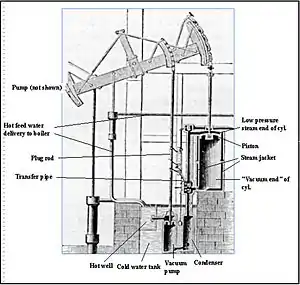| |||
|---|---|---|---|
|
| 1775 in science |
|---|
| Fields |
| Technology |
| Social sciences |
|
| Paleontology |
| Extraterrestrial environment |
| Terrestrial environment |
| Other/related |
The year 1775 in science and technology involved some significant events.
Biology
Chemistry
- May 25 – Joseph Priestley's account of his isolation of oxygen in the form of a gas ("dephlogisticated air") is read to the Royal Society of London.[2]
- Torbern Bergman's De attractionibus electivis ("A Dissertation on Elective Attractions") is published, containing the largest tables of chemical affinity ever published.
Exploration
- July 30 – 3-year second voyage of James Cook completed, the first eastabout global circumnavigation, during which the Antarctic Circle has been crossed three times, Terra Australis shown to be a myth, and Larcum Kendall's K1 chronometer demonstrated to be a reliable timekeeper for the purpose of calculating longitude.
Mathematics
- Lagrange's Recherches d'Arithmétique develops a general theory of binary quadratic forms.
- First Stanhope Demonstrator, a mechanical device to demonstrate and solve problems in logic, is produced by English aristocrat Charles Stanhope, 3rd Earl Stanhope.[3]
Medicine
- English surgeon Percivall Pott finds the first occupational link to cancer, contributing to the science of epidemiology.
- German physician Melchior Adam Weikard anonymously publishes the textbook Der Philosophische Arzt including the earliest description of symptoms resembling attention deficit hyperactivity disorder.
Natural history
- February 21 – La Specola, Florence's Museum of Zoology and Natural History, opens to the public.
- Johan Christian Fabricius publishes his Systema entomologiæ.
- Peter Forsskål's Descriptiones Animalium: Avium, amphiborum, insectorum, vermium quæ in itinere orientali (containing early observations on bird migration) and Flora Ægyptiaco-Arabica sive descriptiones plantarum quas per Ægyptum Inferiorem et Arabiam felicem detexit are published posthumously, edited by Carsten Niebuhr.[4]
Technology
- May 22 – James Watt's 1769 steam engine patent is extended to June 1800 by Act of Parliament of Great Britain and the first engines are built under it.[5][6]
- Jacques-Constantin Périer operates a paddle steamer on the Seine, but it proves to be underpowered.[7]
- Alexander Cumming patents the S-trap in London, laying the foundations for the modern flush toilet.[8]
- Edinburgh confectioner Charles Spalding devises improvements to the diving bell, adding a system of balance-weights.[9]
- Pierre-Simon Girard, age 10, invents a water turbine.
- December 30 – John Arnold takes out his first patent for improvements in the construction of marine chronometers in Britain, including the first for a compensation balance.[10]
- Approximate date – Thomas Mudge invents the detached lever escapement for clocks and watches.
- French Academy of Sciences made the statement that the academy "will no longer accept or deal with proposals concerning perpetual motion."[11]
Awards
Births
- January 22 – André-Marie Ampère, French physicist (died 1836)
- February 9 – Farkas Bolyai, Hungarian mathematician (died 1856)
- May 10 – William Phillips, English geologist (died 1828)
- July 23 – Étienne-Louis Malus, French physicist and mathematician] (died 1812)
- September 30 – Robert Adrain, Irish-born mathematician (died 1843)
- November 19 – Johann Karl Wilhelm Illiger, German entomologist and zoologist (died 1813)
Deaths
- March 3 – Richard Dunthorne, English astronomer (born 1711)
- May 1 – Israel Lyons, English mathematician and botanist (born 1739; died of measles)
- October 25 – Johan Maurits Mohr, Dutch astronomer (born 1716)
References
- ↑ Kitchener, A.C.; Breitenmoser-Würsten, C.; Eizirik, E.; Gentry, A.; Werdelin, L.; Wilting, A. & Yamaguchi, N. (2017). "A revised taxonomy of the Felidae: The final report of the Cat Classification Task Force of the IUCN Cat Specialist Group" (PDF). Cat News (Special Issue 11).
- ↑ Priestley, Joseph (1775). "An Account of Further Discoveries in Air". Philosophical Transactions of the Royal Society. 65: 384–94. doi:10.1098/rstl.1775.0039. JSTOR 106209.
- ↑ Gardner, Martin (1952). "Logic Machines". Scientific American. 186 (3): 68–69. Bibcode:1952SciAm.186c..68G. doi:10.1038/scientificamerican0352-68. JSTOR 24950629. Archived from the original on 2023-03-23. Retrieved 2023-02-20.
...the first true logic machine, the Stanhope Demonstrator.
- ↑ "The University of Copenhagen – A Danish centre of learning since 1479". Københavns Universitet. Retrieved 2011-05-19.
- ↑ Scherer, F. M. (1965). "Invention and Innovation in the Watt-Boulton Steam-Engine Venture". Technology and Culture. 6 (2): 165–87. doi:10.2307/3101072. JSTOR 3101072. S2CID 112618665.
- ↑ "The Invention of the Steam Engine: The Life of James Watt. Part 4: The Steam Engine Gains Popularity". About.com Inventors. Archived from the original on May 25, 2012. Retrieved 2011-02-25.
- ↑ Spratt, H. Philip (1958). The Birth of the Steamboat. London. p. 35.
{{cite book}}: CS1 maint: location missing publisher (link) - ↑ "The Development of the Flushing Toilet – Detailed Chronology 1596 onwards". Stoke-on-Trent: Twyfords Bathrooms. Archived from the original on 2010-03-22. Retrieved 2011-05-04.
- ↑ Transactions of the Society Instituted at London for the Encouragement of Arts, Manufactures, and Commerce, vol. 1 (3rd ed.), Society of Arts, 1806, pp. 220–232, retrieved 2013-01-22
- ↑ No. 1113. Betts, Jonathan (2004). "Arnold, John (1735/6–1799)". Oxford Dictionary of National Biography (online ed.). Oxford University Press. doi:10.1093/ref:odnb/677. Retrieved 2012-03-09. (Subscription or UK public library membership required.)
- ↑ Scaffer, Simon (June 1995). "The Show That Never Ends: Perpetual Motion in the Early Eighteenth Century". The British Journal for the History of Science. 28 (2): 157–189. doi:10.1017/S0007087400032957. JSTOR 4027676. S2CID 146549874.
- ↑ "Copley Medal | British scientific award". Encyclopedia Britannica. Retrieved 21 July 2020.
This article is issued from Wikipedia. The text is licensed under Creative Commons - Attribution - Sharealike. Additional terms may apply for the media files.
